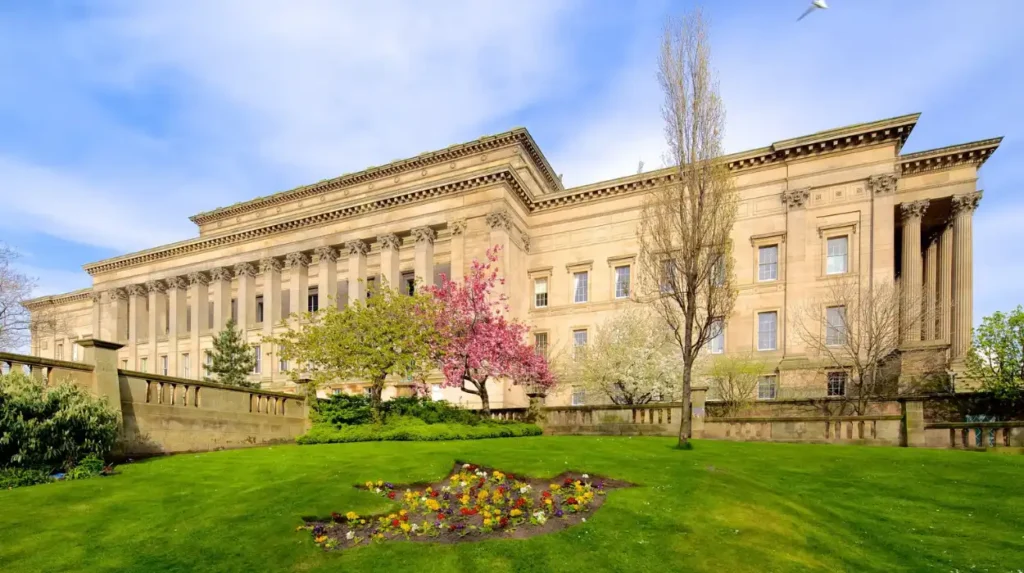St George in the East is an Anglican church located on Cannon Street Road between The Highway and Cable Street in East London. The parish itself dates back centuries but was officially constituted as a Poor Law parish in 1836 following the Poor Law Amendment Act of 1834. The church was constructed from 1714 to 1729 under the guidance of Nicholas Hawksmoor, a notable architect contemporary to Christopher Wren and Sir John Vanbrugh. It was funded through the 1711 Act of Parliament which mandated the building of fifty new churches in London to serve its expanding urban population.
The church’s name has been associated with various forms of ecclesiastical and civil parishes over time, including administrative roles in public welfare until these functions were absorbed by the Metropolitan Borough of Stepney in the early 20th century. Despite changes in governance, the church itself has remained a central fixture in the local area.
Architectural Significance
St George in the East is celebrated as one of the six Hawksmoor churches in London, reflecting a unique blend of Classical architecture influenced by Byzantine and Palladian styles. Its turreted tower and smaller pepperpot-style towers make it an imposing presence. This architectural style not only adds aesthetic value but also symbolizes the historical narrative of religious and urban development in East London.
The church building is a Grade I listed structure, meaning it is recognized for its exceptional architectural and historic interest, warranting every effort to preserve it. Its design and heritage contribute to its role as an iconic landmark in the East End.

St George’s Role in the Local Community
Today, St George in the East continues to serve as a vibrant centre for worship and community engagement. It houses the Centre for Theology and Community, an ecumenical charity working within its crypt to provide services that reach beyond traditional church functions, including social justice initiatives and community support programs. The church welcomes individuals from all races, backgrounds, and ages, reflecting East London’s diverse demographic.
Recent developments include a significant planning permission granted for the creation of 29 affordable homes, a new leisure centre, and enhancements to St George’s Gardens, highlighting the church’s expanding role in meeting housing and community needs in Tower Hamlets.

St George’s Gardens and Surroundings
Behind the church lies St George’s Gardens, which was originally the graveyard. This green space adds to the community-oriented feel of the area and provides an inviting environment for relaxation and gatherings. Enhancements planned for St George’s Gardens as part of the recent development project further emphasize the importance placed on combining heritage preservation with modern community functionality.
Visitor Information and Local Attractions
Visitors and locals alike can admire the church’s architecture and experience its historical significance firsthand. The area around St George in the East, situated near Whitechapel, is known for its bustling street life, multicultural character, and nearby attractions such as the Tower of London and St Paul’s Cathedral. Its location makes it a convenient hub for exploring East London’s rich history and diverse cultural offerings.
Why St George in the East Matters to East Londoners
For East London residents, St George in the East is much more than a historic building; it is a symbol of resilience and community solidarity. Through centuries marked by social upheavals—from religious dissent in the 1850s to modern urban development—the church has remained a steadfast presence. Its ongoing adaptation to contemporary social needs exemplifies the dynamic spirit of East London itself.
St George in the East stands as an evergreen emblem of East London’s heritage and future. Combining historical depth, architectural beauty, and vibrant community engagement, it has evolved while maintaining strong ties to its past. For locals and visitors, it offers a unique glimpse into the continuity of faith, culture, and social progress in one of London’s most dynamic boroughs.
